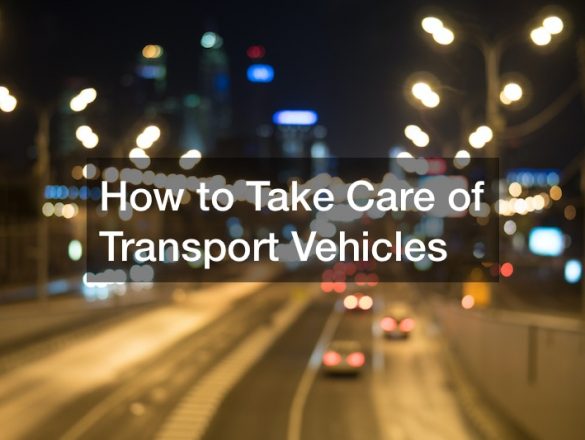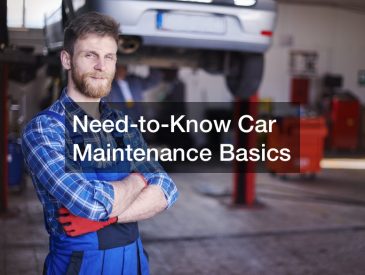
Transport vehicles such as tractors, trucks, semitrailers, and railroad carriages play an integral in different businesses. Unfortunately, taking care of these expert auto transport vehicles is complex and demanding. Regular maintenance, servicing, and repair of transport vehicles are essential to ensure they run smoothly and efficiently. Before we look at how you should do maintenance of transport vehicles, let’s first understand the different industries which use transport vehicles.
Industries That Use Transport Vehicles

Transport vehicles play a crucial role in the logistics sector since they are used to transfer products and machinery from one place to another. Transport vehicles mainly used in the logistics industry include lorries, semitrailers, tow trucks, tail lift trucks, jumbo trailers, flatbed trucks, straight trucks, and refrigerated trucks. For instance, truck vehicles used by trash dumpster rentals help move garbage and bulk trash to treatment and recycling centers. Semitrailers handle long-distance transport due to their HVAC services, whereas bulky items like coal and raw materials for the industry are transported by straight trucks.
Transportation vehicles are equally vital to the agricultural and farming industries, though many farmers typically opt for truck rental services. Tractors are essential for farmers, as they are used to transport plows, cultivators, and planters. Plants, fertilizer, and farm equipment are all moved by transport trucks. Produce is also shipped on trucks from the farm to distribution centers and markets. When it comes to the construction industry, dump trucks are commonly used to haul soil and other materials to and from job sites. Transporting wet concrete to building sites is done with the help of cement mixers. Trucks and semi-trailers are used in the manufacturing industry to transport raw materials.
Various automobiles are put to use in various fields according to the tasks at hand. Vans, for instance, are utilized for short-distance deliveries, whereas semitrailers are employed for longer journeys. Dump trucks are used for transporting building materials, whereas tractors are utilized for moving farm equipment. To keep running smoothly and for as long as possible, every vehicle has its own unique set of maintenance and repair needs.
The Essential Maintenance and Repair Routines for Transport Vehicles
Maintaining transportation vehicles on a regular basis is crucial to their continued safe and reliable service. Accidents, breakdowns, and unnecessary expenditures on repairs are all possible outcomes of ignoring expert auto transport vehicle maintenance. As a result, it’s crucial to establish periodic maintenance routines.
Inspection of Key Components
Regular inspections of critical parts are necessary for spotting problems before they worsen. The engine, gearbox, and cooling system are the only essential parts that should be inspected in a transport vehicle to save on heavy expenses with major repairs. Fluid levels, hose and belt wear, leaks, and other damage signs are some things that could be examined during an inspection. Regular inspections are necessary for spotting issues early and preventing failures. A more in-depth evaluation could need to take the car to a professional technician.
Electrical System Inspection and Repair
The starter, alternator, lights, and audio/video systems rely on the vehicle’s electrical system, so it’s important to be inspected and serviced often. Unexpected breakdowns can be avoided, and proper component performance can be guaranteed with routine examination and maintenance of the electrical system. All wiring and connections should be tested for strength and deterioration to ensure the electrical system’s safety. The terminals and state of charge of the battery should also be examined. Any problems found during the examination should be fixed without delay. Wires, connections, and fuses may need to be replaced during repairs. Depending on the nature of the damage and the components that must be replaced, the price of repairs may range widely. On average, electrical repair for an expert auto transport vehicle at a charging station costs $100 to $500.
Suspension and Steering Inspection and Repair
A vehicle’s suspension and steering system should be inspected and repaired regularly to provide a comfortable and secure drive. Routine inspections can catch problems like worn shock absorbers, and broken tie rod ends early. Check for leaks, damage, and general wear and tear in the steering and suspension systems. Issues found during the examination should be fixed without delay. Damaged or worn suspension components such as shocks, struts, ball joints, and tie rods may need to be replaced as part of the repairs. Depending on the nature of the damage and the components that must be replaced, the price of repairs may range widely. Fixing the suspension and steering might cost anywhere from $500 to $1500 on average.
Common Repairs and Replacement for Transport Vehicles
Windshield and Window Replacement

Expert auto transport vehicles are mostly exposed to vigorous activities that can lead to window and windshield breakdown. Therefore, you will need windshield and window replacement within the short time after such uncertainties occur. Windows and windshields of transport vehicles serve two purposes: they protect the driver from the harsh exterior elements and improve their field of view. Defects to the windshield, such as chips or cracks, can reduce visibility and increase the risk of an accident. It’s time to get a replacement when the damage is too severe to be fixed. The cost of replacing windshields and windows at reliable glass contractors varies depending on vehicle type, model year, and glass grade. A windshield replacement might cost anywhere from $200-$500 on average.
Brake Repair and Replacement
One of the most important aspects of car safety is the braking system. To keep the system running smoothly, brakes need to be checked, repaired, and replaced on a regular basis. Replacement of brake pads, resurfacing of brake rotors, and replacement of brake lines are all typical brake repairs. Repair prices for braking systems fluctuate with factors such as damage severity, vehicle model, and brake system design. Both rotor resurfacing and brake pad replacement may run you between $200 and $400 on average.
Mechanical Servicing and Overhaul
The transport vehicle’s engine is its lifeblood; if it’s damaged, the car won’t go anywhere. You should consider fixing the expert auto transport engine by either changing the head gasket, or adjusting the engine mounts. If the engine is severely damaged or worn out, it may need to be replaced. Repairing or replacing an engine can be expensive, but the exact amount can’t be estimated without knowing the vehicle’s make, model, and engine. Engine replacement can be between $2,500 and $5,000, while repairs can cost anywhere from $500 to $2,000.
Maintenance of Vehicle Transmissions
The gearbox is an integral part of transportation vehicles since it is responsible for shifting gears and transmitting engine power to the wheels. Changing the fluid, repairing the shifter, or replacing the clutch are all possible transmission repairs. In extreme cases, it may be necessary to replace the transmission. The cost of transmission work varies widely depending on a number of variables, such as the type of transmission the car has, the extent of the damage, and the vehicle’s make and model. Transmission replacement can cost between $3,000 and $6,000, while transmission repairs average approximately $2,000.
Wheel and Tire Replacement

Tires and wheels should be checked and replaced at regular intervals because of how important they are to the safe operation of a vehicle. Common services for wheels and tires include fixing flats, realigning wheels, and balancing tires. Wheel and tire repair and replacement costs differ from vehicle to vehicle, tire to tire, and damage to damage, among other factors. Wheel alignment and tire balancing can cost between $50 and $150, while tire replacement can cost $100 to $300 per tire.
Maintenance Of The Exhaust System
Emissions, noise, and fuel economy may all be improved by adjusting the exhaust system. Fixing leaks, changing catalytic converters, and muffler work are common exhaust system repairs. Exhaust system repairs and replacement costs differ from vehicle to vehicle and by the kind of exhaust system being fixed or replaced. The average cost to fix an exhaust system is around $600, while the average cost to replace it is over $2,000.
Best Practices for Vehicle Care
Regular Cleaning and Washing
Keeping your car clean is a preventative measure against deterioration and improves its overall appearance. Buildups of dirt, filth, and salt may lead to corrosion and rust, which can lead to costly repairs. You may delay the onset of rust by washing your car’s exterior with soap and water on a regular basis. You can also make your expert auto transport vehicle’s components last longer if you keep the inside clean by vacuuming the carpets and washing down the dashboard and seats. A protective wax coating should be applied every three to four months, and you should wash your car at least once every two weeks.
Safe and Secure Parking
If you want to keep your expert auto transport vehicle in good condition for as long as possible, proper storage is essential. Keep your automobile protected from harsh environmental elements by storing it in a garage whenever possible. You can also request the parking lot contractors to help you out. Automated gates will keep your transport vehicle inaccessible from car robbers. There are many garage door companies that sell and install automated gates to enhance the security of your expert auto transport vehicle. It is necessary to properly prepare your car for long-term storage, such as during the winter months. You must also change the oil, remove the battery, and inflate the tires to the correct pressure. Covering your car may also protect the paint from dust and other environmental hazards.
Safe Driving Habits

Keeping yourself and your vehicle safe on the road is a top priority. Drive aggressively, and you risk premature part failure from acceleration and braking. The suspension and braking systems in your automobile will wear out sooner if you overload it. Keeping a reasonable following distance will help you prevent accidents and save wear and tear on your brakes.
How To Take Care of Transport Vehicles That Carry Goods
Vehicles that haul goods are the ones that need the most regular maintenance because of their greater exposure to wear and tear from frequent usage. Therefore, you should prioritize the maintenance of these vehicles if you want them to last longer and continue functioning at a high level every day.
There must be a mechanism to ensure that all cars are examined after a certain time on the road (this may be determined by keeping records of the vehicles’ and drivers’ activities). After that, you’ll need to discuss with the driver and do a comprehensive vehicle examination to see whether any servicing or repairs are required.
It’s important to hire licensed drivers to operate the vehicles in question, as they will be better versed in the intricacies of each vehicle and how to keep everyone inside of it safe. In addition, you should have a group of competent technicians to do routine upkeep and any necessary repairs.
Any expert auto transport vehicle that spends a lot of time on the road is susceptible to dirt which is harmful if not regularly cleaned. In light of this, you should thoroughly clean the good transport vehicle after each trip. This involves washing the inside, the outside, and the undercarriage. It will not only keep the cars free of any potentially hazardous filth and grime but will also keep them looking clean and presentable.
Applying ceramic coating, a liquid polymer similar to wax or polish produces a hard, glossy surface. This makes your expert auto transport vehicle look good and protects them from the harmful effects of the sun and other substances they can encounter on the road. The typical ceramic coating cost is reasonable and worthwhile since it safeguards your automobiles and makes them seem better. Goods vehicles covering long distances require high-quality tyres, like marathon runners require decent shoes. A vehicle’s performance and longevity on the road may be greatly improved by simply checking the tire pressure once a week and maintaining the correct level at all times.
If you follow these guidelines, your transport vehicles will last longer and require less maintenance. Good maintenance is essential to the success of your business, since expert auto transport vehicles and delivery trucks are subjected to more wear and tear than ordinary cars.




